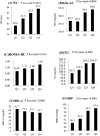Association of Non-alcoholic Fatty Liver Disease with Metabolic Syndrome Independently of Central Obesity and Insulin Resistance
- PMID: 27246655
- PMCID: PMC4887873
- DOI: 10.1038/srep27034
Association of Non-alcoholic Fatty Liver Disease with Metabolic Syndrome Independently of Central Obesity and Insulin Resistance
Abstract
Non-alcoholic fatty liver disease (NAFLD) is an emerging chronic liver disease that may lead to liver cirrhosis and hepatocellular carcinoma. We aimed to determine the association between the prevalence of metabolic syndrome (MetS) and NAFLD severity using semi-quantitative ultrasonography (US). A total of 614 participants were recruited from the community. NAFLD was evaluated according to the ultrasonographic Fatty Liver Indicator (US-FLI), which is a semi-quantitative liver ultrasound score. Insulin resistance was estimated with the homeostasis model assessment index for insulin resistance (HOMA-IR). NAFLD and MetS were found in 53.7 and 17.3% of the participants, respectively. Linear relationships were found between the severity of NAFLD and waist circumference, fasting glucose, HOMA-IR, triglycerides, HDL-C and blood pressure. After adjusting for confounding factors, i.e., body mass index and HOMA-IR, the odds ratios for MetS were 3.64 (95% confidence interval (CI): 1.5-8.83) for those with mild NAFLD and 9.4 (95% CI: 3.54-24.98) for those with moderate-to-severe NAFLD compared to those without NAFLD. The combination of the HOMA-IR and US-FLI scores better differentiated MetS than the HOMA-IR alone. In addition to obesity, the severity of NAFLD and the HOMA-IR both play important roles in MetS. Whether NAFLD is a component of MetS warrants further research.
Figures

References
-
- Farrell G. C., Wong V. W.-S. & Chitturi S. NAFLD in Asia-as common and important as in the West. Nat Rev Gastroenterol Hepatol 10, 307–318 (2013). - PubMed
-
- Lonardo A. et al.. Epidemiological modifiers of non-alcoholic fatty liver disease: Focus on high-risk groups. Dig Liver Dis. 47, 997–1006 (2015). - PubMed
MeSH terms
Substances
LinkOut - more resources
Full Text Sources
Other Literature Sources
Medical
Molecular Biology Databases

